Singapore Design Trends 2025: How Singapore Homes Are Embracing Mindful Living
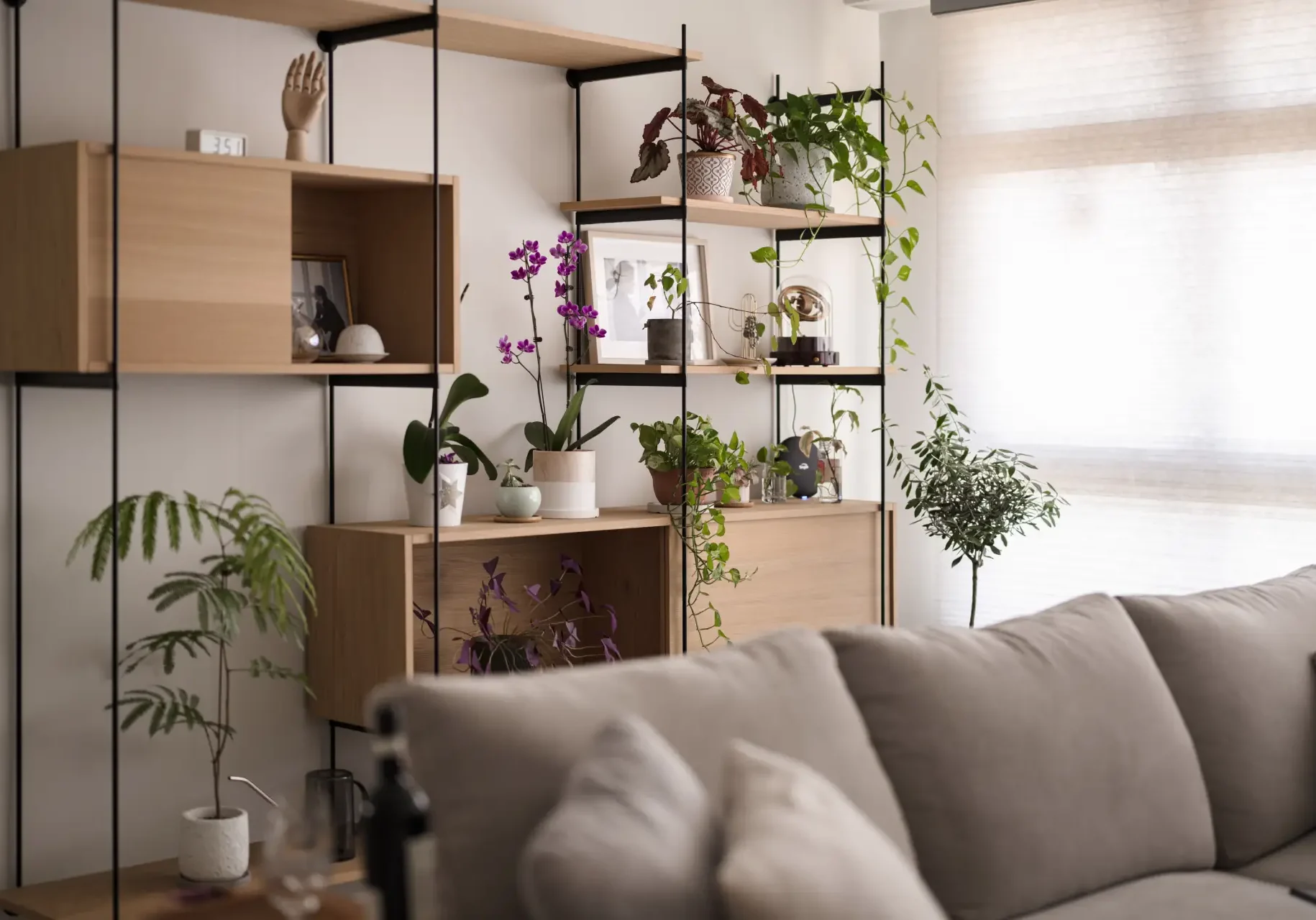
Wellness and tranquillity over extravagance and formalities are shaping the future of home design in today’s Singapore. Living in mindfulness has become the essence of this paradigm shift, and this is reflected through home interior design that consciously supports ‘calm minds and revived souls. Today, it has become crystal clear that more people are looking for ‘spaces that have souls’, where all details are considered, and that lie closer to nature, unlike just offering ‘fast luxury.’
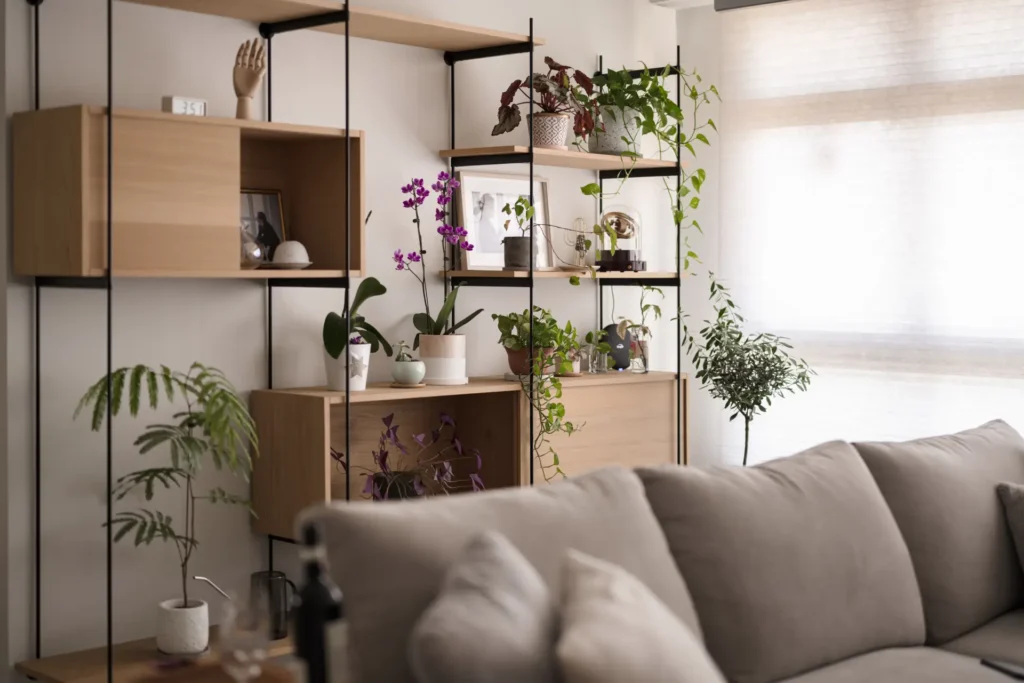
Why Mindful Living Matters in Home Design
Being mindful about interior design incorporates much more than clean, uncluttered rooms and meaningful items within them. It is one of many ways that people can organise their lives, putting a focus on well-being and intentionality. Many people in Singapore associate their mindful homes and lifestyles with relaxing spaces and natural items.
Generally, urban living today comes with its own set of challenges, including fast-paced lifestyles, more people working from home, and always juggling between urban buzz and the need for retreat. That is the reason why today, More Singaporeans have drifted away from “fast luxury” and towards what could be termed as “conscious luxury.”
Additionally, remote work trends and wellness habits have encouraged people towards homes that help them practice self-care. There is a demand for corners of homes that could be used for meditation, yoga, and reading, and all these help calm one’s mind as well. Light, scent, and natural materials are also essential, and these are not only design elements, but they lay down clear foundations of a mindful space.
The Rise of Wellness-Centred Interiors in Singapore
With health and happiness dominating discussions in 2025, their reflection is evident in design as well. Living in a space that can help one truly unwind and recharge can not be overlooked anymore, as lighting, designing, and furnishing a space can affect one’s mood and ability to focus effectively. Some of the key examples are:
- Meditation corners: They are small, defined areas allocated for meditation and help create a peaceful environment.
- Soft, Layered Lighting: Mixing table lamps, wall fixtures, and candles allows for varied lighting effects for varied activities and moods.
- Decluttered Layout: Removing clutter and optimising space through minimal furniture and improved storage solutions will help create open and relaxing environments.
- Corners for aromatherapy: Soothing and gentle scents evoke feelings of relaxation.
- Functional Storage Solutions: Clever shelving and multi-functional furnishings help keep clutter under control.

Biophilic Design — Bringing Nature Indoors
Biophilic design is at the centre of mindful living in 2025, and this has been embraced within homes across Singapore. The tenets of biophilic design revolve around bringing people back into nature through greenery, light, and natural elements in the environment.
Residents enjoy a mindful design indoor garden that usually includes vertical foliage, potted trees near entryways, and kitchens that open into sunny courtyards. But these features have more than just practical applications, as indoor gardens have shown numerous benefits:
- Improved air quality: They purify and clean indoor air, making it easy to breathe and improving health.
- Stress relief: Greenery has a psychologically soothing effect that relieves stress and invites relaxation.
- Connection to Nature: Even flats within urban settings can be connected and have a natural feeling through living elements that can be placed around.
- Productivity boost: Research has indicated that people who work or study near plants have improved focus and cognitive ability.
- Visual harmony: Organic shapes and vibrant greens add balance and softness to modern architecture.
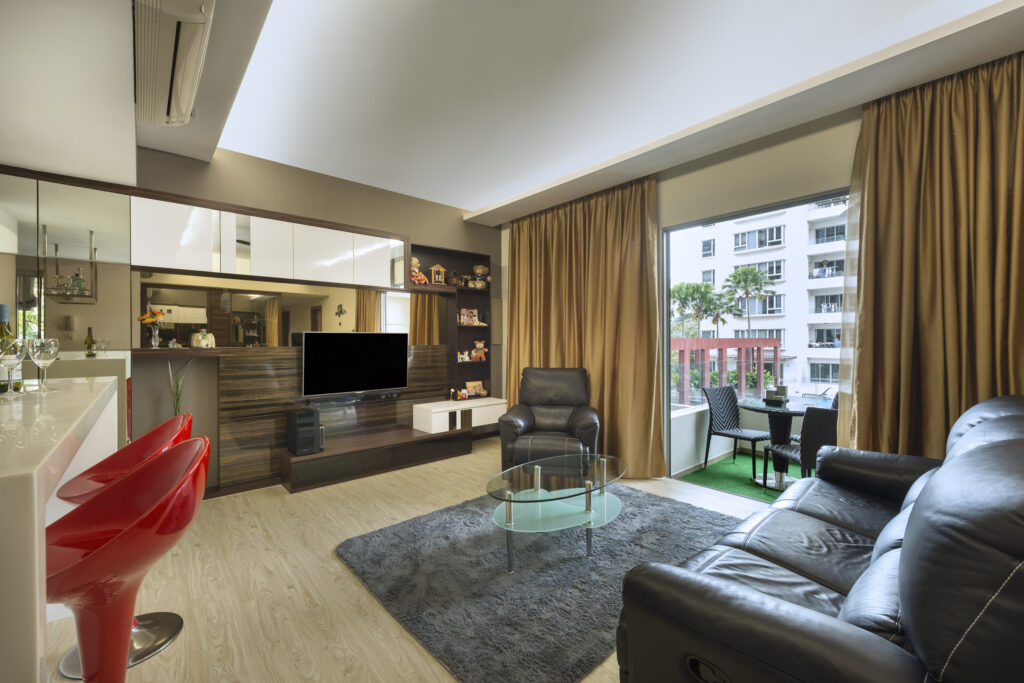
Bold Colours with a Purpose
The era of all-white and hyper-minimal homes is evolving; 2025 sees the return of colour, thoughtfully and strategically applied. Designers are now embracing colour with clear intention. Colour psychology ensures every hue serves a wellness purpose:
- Forest Green and Blush Pink: Calms and uplifts the home.
- Coral and ivory: Brings warmth and vitality to kitchens or dining areas.
- Sandy Beige & Gold: Brings a relaxing and calm feeling into bedrooms.
- Soft blue and moss: Create a relaxing ambience perfect for bathrooms or corners.
These combinations are not arbitrary but are chosen for their power to evoke specific feelings in different rooms, serenity in bedrooms, energy in study spaces, and peace in living quarters.

The Indoor-Outdoor Flow — Reconnecting with Space
2025 also delivers a strong trend towards blurring the boundaries between indoor and outdoor living. Singapore’s climate is ideal for cultivating this seamless flow, with resort-style layouts drawing inspiration from tropical environments.
Design strategies for seamless indoor-outdoor living:
- Sliding glass doors open to leafy balconies or gardens.
- Courtyard lounges with potted palms and smooth stone for a natural feel.
- Outdoor-inspired furnishings and materials can be used inside to echo garden retreats.
- Balconies or patios that become secondary living rooms for relaxation.
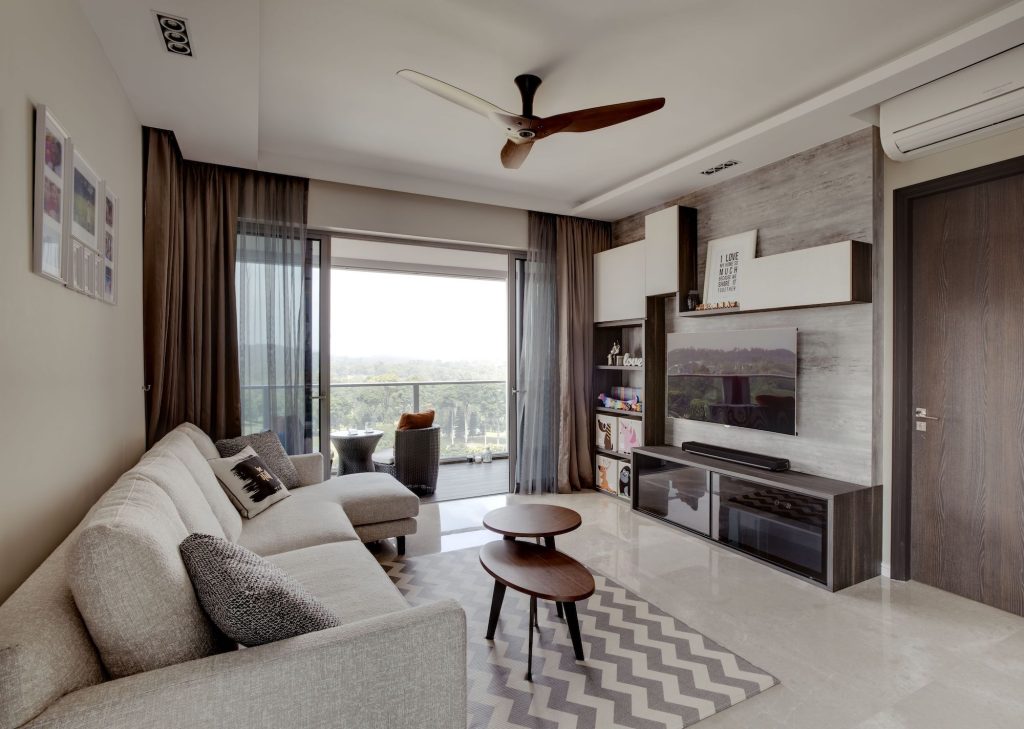
Sustainable Luxury — Designing with Intention
Sustainable luxury lies at the heart of mindful design in 2025. Homeowners increasingly demand materials and practices that reflect personal values as well as refined taste. Energy-efficient lighting, responsibly harvested timber, and recycled glass worktops are no longer novel upgrades, but essentials in contemporary Singaporean homes.
Also, luxurious and sustainable furniture and furnishings are being incorporated into what is considered the most coveted interior environments. Where aesthetics meet responsible design, a new paradigm that is defined more by craftsmanship and sustainability than by price tag.
By emphasising wellness facilities, projects that specialise in this niche market differentiate themselves through:
Spa zones; or spa facilities, that are hydrotherapy or sauna rooms on site for wellness.
Rooftop gardens: Serve as areas for relaxation, gardening, or parties surrounded by lush vegetation.
Yoga and meditation studios: Well-lit rooms ideally suited for group or private practice sessions.
Air purification: Ventilation systems ensure clean, breathable air.
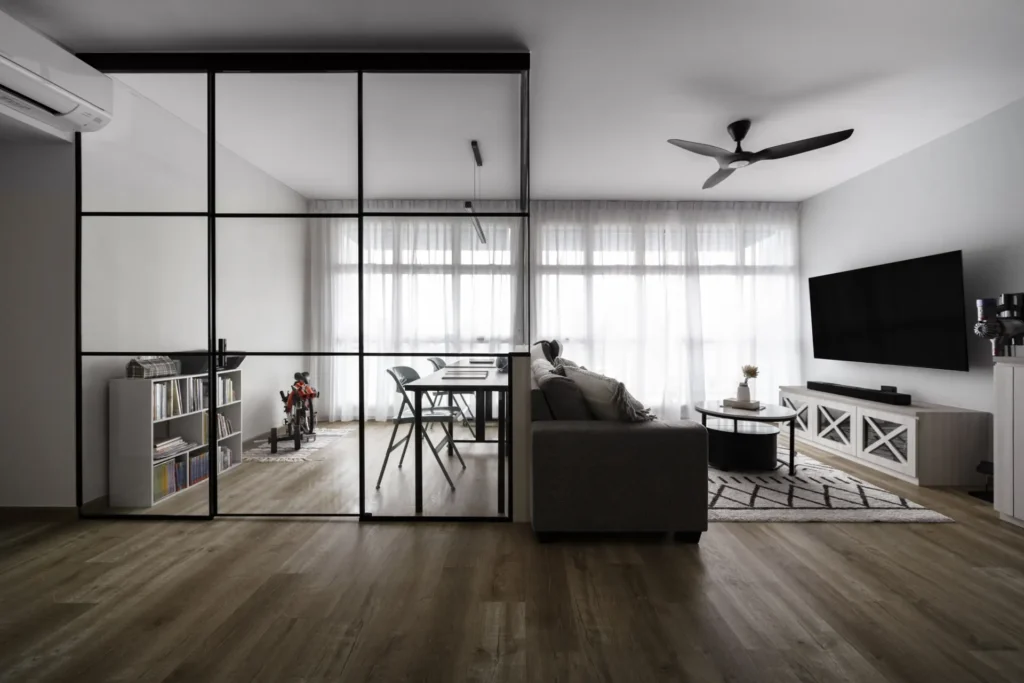
The Sensory Home — Designing for Peace and Focus
The “sensory home” of today is also on a roll; the designers’ focus is on more than just sight, they incorporate touch, sound, and scent too, emphasising tranquillity and concentration:
- Texture is a major player: think hand-tufted rugs, cool marble counters, or textured wall panelling for acoustic comfort.
- Scented candles and essential oils: Fragrances that define areas and emotions.
- Acoustic Planning: Floor coverings reduce acoustic reflections, creating a peaceful environment.
- Variable lighting: Soft and warm colours that adapt and respond to activities and time of day.
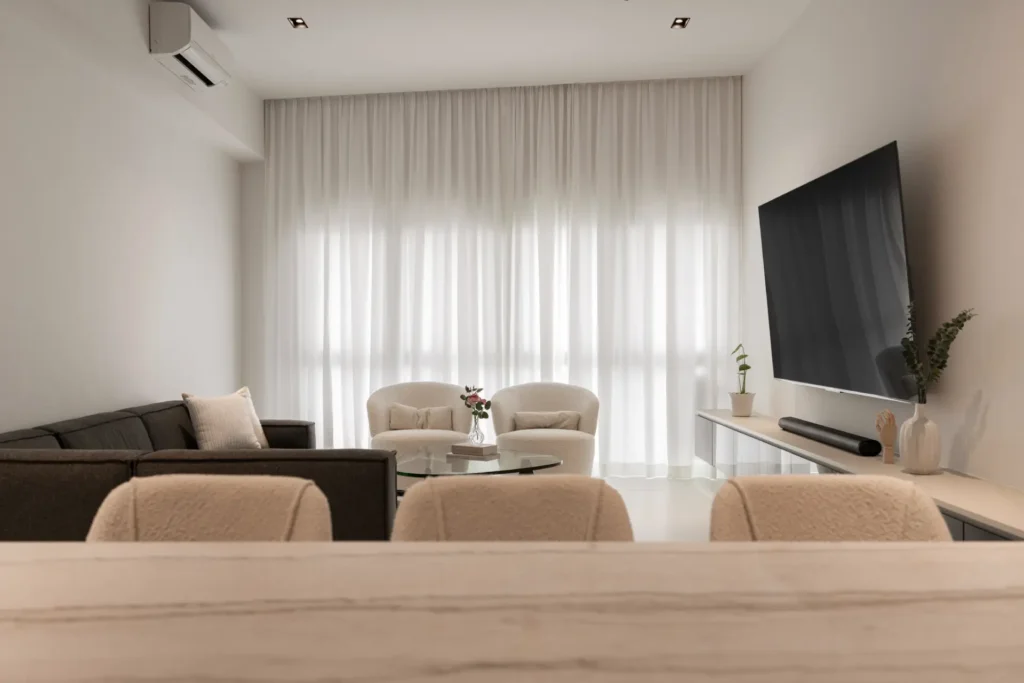
Creating Your Own Mindful Home
Applying the concepts of mindful interior design within one’s own home is easy and very gratifying. To begin, start with these small, impactful changes:
- Declutter on purpose; choose items that bring joy or have a practical purpose.
- Instead of heavy curtains, use sheer curtains that allow ample natural lighting.
- Set up a small wellness area with a plant, light, and seating.
- Use environment-friendly home furnishings, such as bamboo chairs and organic linen cushions.
You can also enhance your workspace environment through mindful office design elements such as ergonomic office chairs, gentle lighting, and soothing colours.
Above all, your design should incorporate your own personal rhythm of living. Personalisation is key to mindful interior design, and this is achieved through creating a space that meets your emotional and practical needs.
Final Thoughts — The Future of Mindful Design in Singapore
2025 stands as a turning point for Singaporean designs, ushering in a future where homes function as sanctuaries, and every element, from layout to material, is carefully selected to support both mental and physical well-being. This new era is mindful by design.
At This Mood Board, a passion for living life holistically and on one’s own terms is at the forefront of all that we undertake. Whether we are designing spa-like bathrooms, garden-centric living areas, and character-filled bedrooms, all of this is undertaken for one reason only, namely, actualising that paradise you have been dreaming of. If this is what you are looking for, check out our portfolio and contact us today!
Frequently Asked Questions
What is mindful living in the 2025 Singapore design?
It means spaces that create calm, free-from-clutter homes for mental and physical well-being. This design focuses on natural elements, stress reduction, and balancing work time with time to relax.
How do I apply mindful design in a small HDB or condo?
Consider multi-functional furniture, smart storage, and the use of vertical space. Designate clear “zones” for activities by using area rugs or lighting, and just a “less is more” philosophy in general.
What colours and materials are trending?
Think terracotta, muted greens, and warm beiges. More tactile materials also: light woods, rattan, linen, and unpolished stone add texture and warmth.
How does this fit in with sustainability?
Mindful living also honours the idea of sustainability. This includes choosing durable, long-lasting furniture over “fast furniture”; investing in upcycled or repurposed vintage pieces; and using energy-efficient appliances.